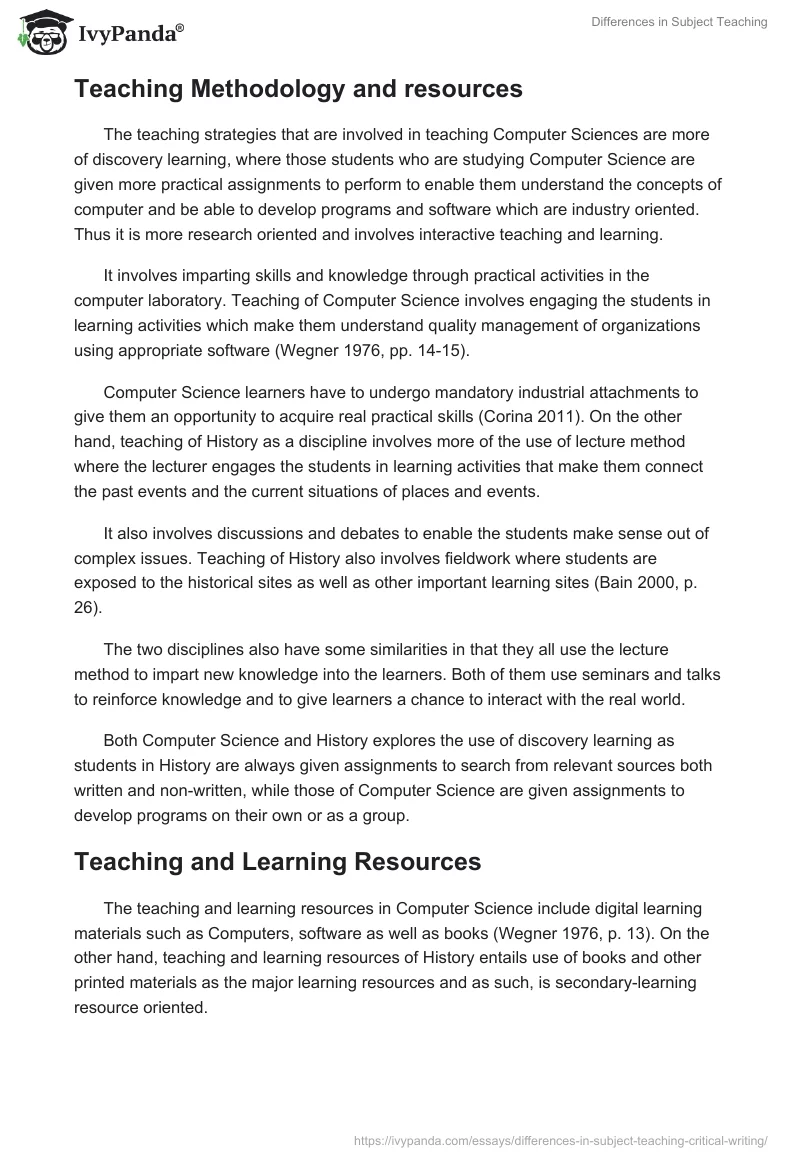Introduction
Teaching of Computer Science and History has both similarities and significant differences in various aspects of teaching and learning processes. These aspects include the teaching and learning methodologies, the resources used as well as the teaching and learning content.
Similarities and Differences
Teaching and learning Content
The learning content for History as a discipline focuses on achievements of the past including past events and experiences of nations and regions in the world, cultures, continuity and changes that have occurred over time as well as the cause-and-effect relationships (Furay, & Salevouris 2000, p. 11). The learning content is therefore more theoretical.
Conversely, the content in Computer Science concentrates on learning characteristics of programs that are employed in software development and innovations of new programs. They also assists the learners on how to modify the existing software Thus the learning content for computer science is more practical and organizational activity management oriented (Corner, Denning, Gries, Mulder, Tucker, Turner & Young 1989, p. 9).
It is also important to note that both Computer Science and History study their own theoretical foundations and are all presented in theoretical form. History also has a sub-field in archaeology which also uses practical techniques to study the developments of human existence just the same way Computer Science uses practical computation techniques in its learning content. Besides, both learning contents include theories that explain facts.
Teaching Methodology and resources
The teaching strategies that are involved in teaching Computer Sciences are more of discovery learning, where those students who are studying Computer Science are given more practical assignments to perform to enable them understand the concepts of computer and be able to develop programs and software which are industry oriented. Thus it is more research oriented and involves interactive teaching and learning.
It involves imparting skills and knowledge through practical activities in the computer laboratory. Teaching of Computer Science involves engaging the students in learning activities which make them understand quality management of organizations using appropriate software (Wegner 1976, pp. 14-15).
Computer Science learners have to undergo mandatory industrial attachments to give them an opportunity to acquire real practical skills (Corina 2011). On the other hand, teaching of History as a discipline involves more of the use of lecture method where the lecturer engages the students in learning activities that make them connect the past events and the current situations of places and events.
It also involves discussions and debates to enable the students make sense out of complex issues. Teaching of History also involves fieldwork where students are exposed to the historical sites as well as other important learning sites (Bain 2000, p. 26).
The two disciplines also have some similarities in that they all use the lecture method to impart new knowledge into the learners. Both of them use seminars and talks to reinforce knowledge and to give learners a chance to interact with the real world.
Both Computer Science and History explores the use of discovery learning as students in History are always given assignments to search from relevant sources both written and non-written, while those of Computer Science are given assignments to develop programs on their own or as a group.
Teaching and Learning Resources
The teaching and learning resources in Computer Science include digital learning materials such as Computers, software as well as books (Wegner 1976, p. 13). On the other hand, teaching and learning resources of History entails use of books and other printed materials as the major learning resources and as such, is secondary-learning resource oriented.
They also have some similarities when it comes to resource usage. They both use secondary sources of learning materials such as books, the internet among others to source knowledge and skills relevant for each discipline (Peters,1985).
Conclusion
Teaching and learning of the two disciplines differ significantly due to their disparities in the learning contents. While Computer Science is more practical oriented, History is to larger extent, theoretical.
Reference List
Bain, R. B., 2000, Knowing, teaching & learning history. New York: New York University Press. p. 26.
Corina, N., 2011, Teaching strategies in training of computer science teachers and informational and communicational technologies. Web. Accessed at http://www.cnaa.md/en/thesis/18256/ on 20 January, 2010.
Corner, D.E., Denning, P. J., Gries, D., Mulder, M. C., Tucker, A., Turner, A. J., & Young, P. R., 1989, Computing as a discipline: Communications of the ACM, 32 (1). New York: Van Nostrand Reinhold. p. 9.
Furay, C., & Salevouris, M. J., 2000, The methods and skills of History: A practical guide, 2nd edition. New Jersey: Harlan Davidson. p. 11.
Peters, P., 1985, ‘Writing as a means of inquiry: why write?’, in Strategies for student writers: A guide to writing essays, tutorial reports, exam papers and reports. John Willey & Sons, Brisbane, pp 1-11.
Wegner, P., 1976, Research paradigms in computer science: Proceedings of the 2nd international Conference on Software Engineering. San Francisco, California, United States: IEEE Computer Society Press, Los Alamitos, CA. pp. 13-15.


